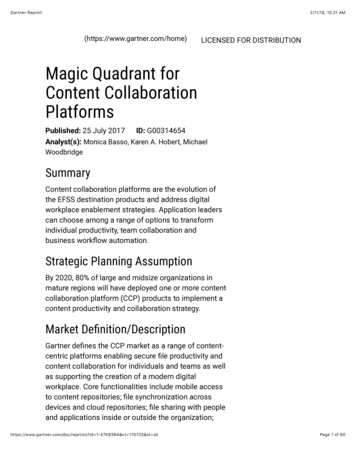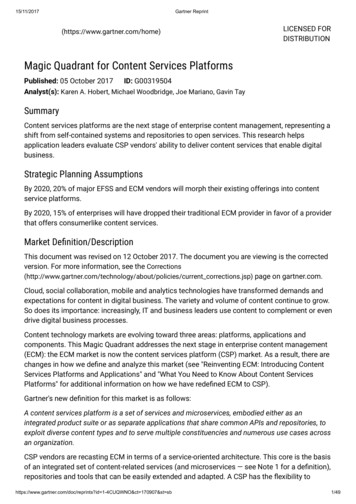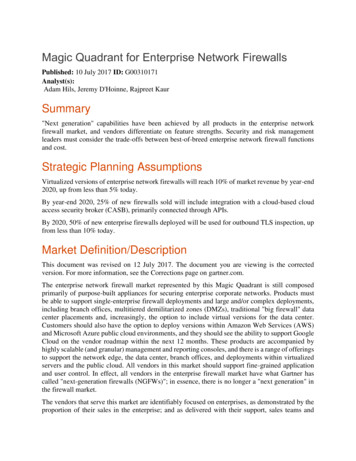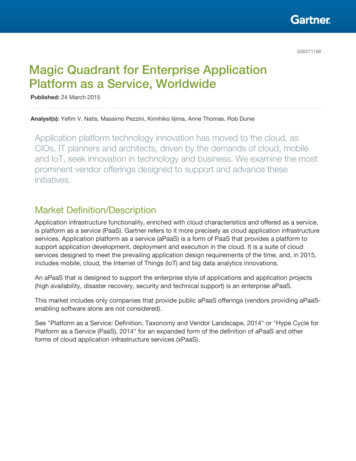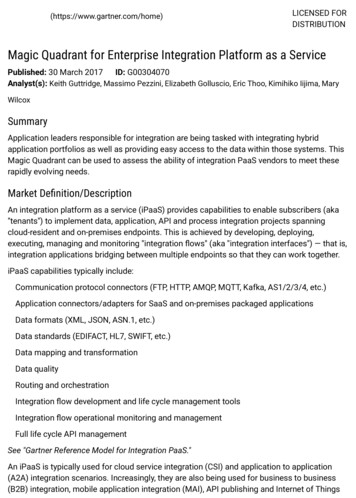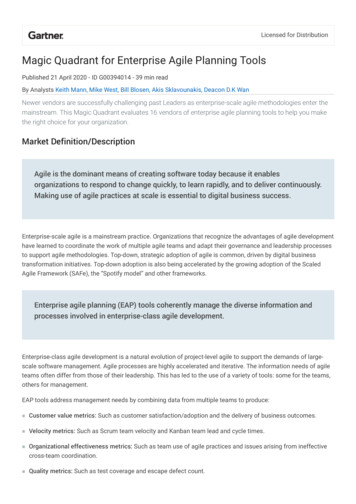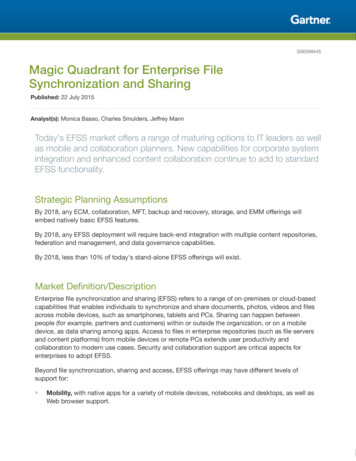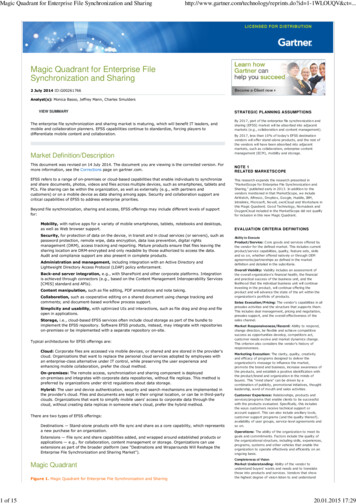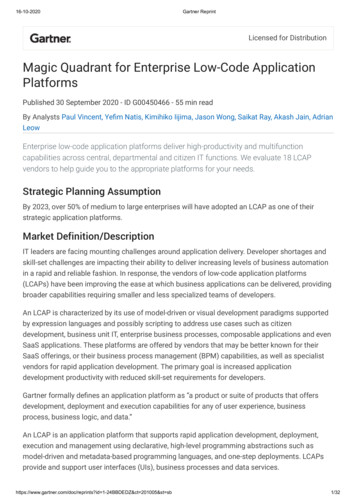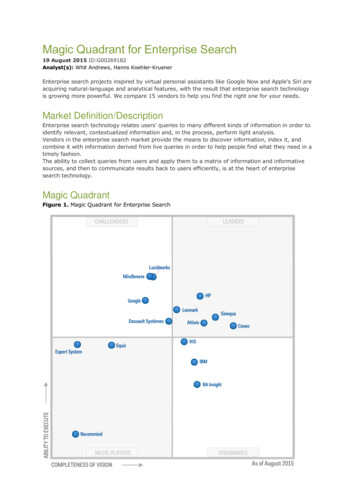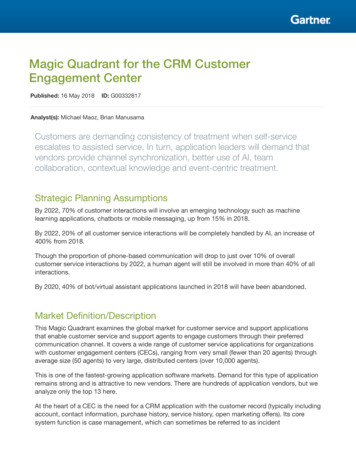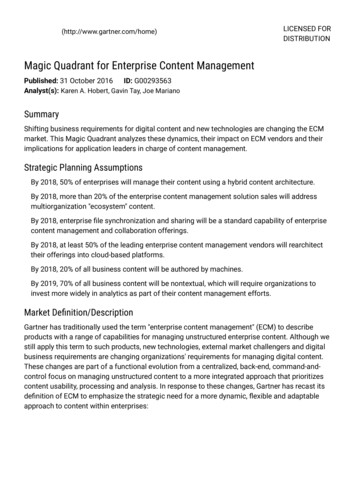
Transcription
(http://www.gartner.com/home)LICENSED FORDISTRIBUTIONMagic Quadrant for Enterprise Content ManagementPublished: 31 October 2016 ID: G00293563Analyst(s): Karen A. Hobert, Gavin Tay, Joe MarianoSummaryShifting business requirements for digital content and new technologies are changing the ECMmarket. This Magic Quadrant analyzes these dynamics, their impact on ECM vendors and theirimplications for application leaders in charge of content management.Strategic Planning AssumptionsBy 2018, 50% of enterprises will manage their content using a hybrid content architecture.By 2018, more than 20% of the enterprise content management solution sales will addressmultiorganization "ecosystem" content.By 2018, enterprise file synchronization and sharing will be a standard capability of enterprisecontent management and collaboration offerings.By 2018, at least 50% of the leading enterprise content management vendors will rearchitecttheir offerings into cloud-based platforms.By 2018, 20% of all business content will be authored by machines.By 2019, 70% of all business content will be nontextual, which will require organizations toinvest more widely in analytics as part of their content management efforts.Market Definition/DescriptionGartner has traditionally used the term "enterprise content management" (ECM) to describeproducts with a range of capabilities for managing unstructured enterprise content. Although westill apply this term to such products, new technologies, external market challengers and digitalbusiness requirements are changing organizations' requirements for managing digital content.These changes are part of a functional evolution from a centralized, back-end, command-andcontrol focus on managing unstructured content to a more integrated approach that prioritizescontent usability, processing and analysis. In response to these changes, Gartner has recast itsdefinition of ECM to emphasize the strategic need for a more dynamic, flexible and adaptableapproach to content within enterprises:
ECM is a set of services and microservices, embodied either as an integratedproduct suite or as separate applications that share common APIs andrepositories, to exploit diverse content types, and serve multiple constituenciesand numerous use cases across an organization.For more details and the rationale behind the new definition, see "Content Management for theDigital Era: Rethinking Strategies Beyond 2016."These changes are bringing new dynamism, growth and innovation to a mature market. Thatmarket consists of buyers who want to exploit diverse types of content for their digital businessactivities, and sellers who offer software and services to manage an increasingly diverse range ofdigital content across enterprise repositories and systems.Application leaders responsible for content management should understand the following forcesthat are affecting the ECM market:New business requirements, such as those introduced by the digital workplaceTechnological evolution, as evidenced by the rise of cloud and hybrid content servicearchitecturesOperational factors, such as new types of technology buyers and a focus on mobilized andconsumer-like user experiencesA new organizational emphasis on creating and improving content-centric processes thatboost productivity, foster digital business, and facilitate the use and sharing of informationIn addition, there is a corresponding evolution of ECM functionality to support the use of contentin business processes, provide business intelligence (BI) and insight, and empower users as theywork.This Magic Quadrant reflects that evolution by identifying eight essential functional componentsthat characterize an ECM product (see Note 1). The 2015 Magic Quadrant on this topic identifiedseven such components, including the now-removed web content management component (nowan extended capability). This year, we have added two new components: analytics/BI, andpackaged apps and integration.The weightings of some of the components have also changed this year: image-processingapplications and content workflow are now deemed somewhat less important, due to theirrelative technological maturity; extended components, by contrast, are now consideredsomewhat more important, as ECM use cases are encompassing broader workloads andcapabilities. The new weightings reflect a shift in our perception of ECM trends andaccommodate new functional requirements. Further details on the changes are included in Note1.Only vendors that offer four or more of the eight functional components (without the need forthird-party add-on components or customizations) were considered for inclusion in this MagicQuadrant.Magic Quadrant
Magic QuadrantFigure 1. Magic Quadrant for Enterprise Content ManagementSource: Gartner (October 2016)Vendor Strengths and CautionsAlfrescoAlfresco (http://www.alfresco.com/) is based in Maidenhead, U.K. and San Mateo, California, U.S. Itsells ECM products, based on open standards, for on-premises, cloud (SaaS and private) andhybrid deployment: the Alfresco One and Alfresco in the Cloud product lines. Alfresco's ECM
platform leverages open standards to provide an integrated solution that can be customized andextended through public APIs. The ECM platform works with Alfresco One Records Managementand the Alfresco Activiti business process management (BPM) product.STRENGTHSAlfresco's open-source-based platform is attractive to technology buyers who want tocustomize and optimize their ECM implementations in a variety of deployments and cloudimplementations.A new marketing strategy has shifted Alfresco's focus to three key direct sales verticals:financial services, government and healthcare. Strong year-over-year growth puts it on a steadycourse as it expands into new regions, especially Asia/Pacific.Alfresco is sharply focused on platform expansion, optimization, scalability and extensibility,and has strategic technical partnerships with Amazon Web Services (AWS), Google andSalesforce.CAUTIONSOutside its three target industries, Alfresco leaves some key business and vertical extensionsand solutions largely to third-party integrators. Application leaders in charge of ECM shouldtherefore assess the experience and capabilities of these third parties.Alfresco's technology and platform focus appeals to IT and application developmentprofessionals, but is less attractive to line-of-business (LOB) buyers, who typically look forpurpose-focused solutions. Application leaders in charge of ECM should focus on matchingAlfresco's platform capabilities and integrated third-party solutions with their businessrequirements to fill gaps.Alfresco has been slow to introduce native integration via connectors or plug-ins with ERP andother popular LOB solutions. Customers needing such integrations should work with third-partypartner integrations or build the integrations themselves.Dell EMCDell EMC (http://www.emc.com/) , which is based in Hopkinton, Massachusetts, U.S., has a contentmanagement portfolio that includes the EMC Documentum products Documentum,ApplicationXtender, xCP, Captiva and Records Manager. All products are offered via on-premisesor private cloud delivery models. In May 2016, the Leap product family was announced — a set ofcloud-based, multitenant and modular content applications. Dell EMC also plans to release asuite of content microservice APIs. This vendor has numerous solutions that support mostindustries and business processes.On 12 October 2015, a definitive agreement was reached that Dell, together with its owners,Michael S. Dell (the founder, chairman and CEO of Dell), MSD Partners and Silver Lake, wouldacquire EMC. The acquisition was finalized on 7 September 2016.In addition, on 12 September 2016, a definitive agreement was reached that OpenText wouldpurchase Dell EMC's Enterprise Content Division, including the Documentum, InfoArchive andLeap product families.STRENGTHS
STRENGTHSDell EMC's platform has a comprehensive set of ECM capabilities, and supports a broad rangeof vertical and horizontal solutions. Recent releases have focused on modernizing userexperiences through mobile support and LOB application integrations.Dell EMC is executing a new cloud ECM strategy characterized by customization andmicrocontent services (Leap), which are designed for content usage and collaboration. Thisresults in a more streamlined and cohesive product offering across the Enterprise ContentDivision brands (Documentum, InfoArchive and Leap).Customer surveys indicate that Dell EMC's customers are generally satisfied with the productsand services they use, as long as they keep up-to-date with the latest software releases.CAUTIONSDisruption related to Dell's acquisition of EMC could have a direct impact on customers and onits ability to execute. Content managers should review purchase and support terms duringcontract negotiations to mitigate potential risks.Dell EMC's Documentum product and pricing options have been an obstacle for midsizebusinesses. However, products like ApplicationXtender and the new Leap services aredesigned to address departmental and midmarket needs.Dell EMC has few technical development partnerships, but it does offer open APIs forextending business-processing and application integrations with third-party tools. Customerswho need broad integration or extensions will likely require development support.EverteamEverteam (http://www.everteam.com/en/) , which is based in Boston, Massachusetts, U.S., sells itsECM platform mainly to midsize and large enterprises in Europe and the Middle East. It offers itsECM platform, which includes cloud enterprise file synchronization and sharing (EFSS)capabilities, via on-premises and cloud delivery models. This vendor recently gained BPMcapabilities through its acquisition of Intalio. Everteam's software integrates with MicrosoftSharePoint and web interfaces using standard web tools and web service APIs. Everteam relieson a strengthened partner network for implementation and support. It concentrates on thefollowing industries: engineering, government, insurance and utilities.STRENGTHSEverteam has a strong focus on regulated industries, especially government and insurance, forwhich it offers strong records management and archiving tools.Everteam received high marks from its reference customers for product support — specificallyfor providing accurate support in a timely manner. This reflects a strong focus on products anddelivery.Everteam's ECM platform now incorporates BPM features — following integration of the Intalioacquisition — for automating the content life cycle.CAUTIONS
Everteam does business predominantly in EMEA. It is de-emphasizing sales activities inAsia/Pacific, and is little known in the U.S. North American buyers will probably find it difficultto purchase Everteam's ECM platform.Everteam's ECM platform has minimal out-of-the-box integration with external toolsets that arenot web-based. Customers who need an ECM platform that can be extended to other LOBapplications and tools should assess alternatives.Everteam's cloud offering is limited to private cloud instances and only available in Europeanmarkets. Buyers for non-European organizations should carefully consider data residency andprivacy rules when deploying content to Everteam's cloud.HylandHyland (http://www.onbase.com/) , which is based in Westlake, Ohio, U.S., markets its OnBasesuite to organizations interested in transaction-associated content and case-centric workloads.The suite is available both on-premises and in the cloud. In 2016, Hyland unveiled ShareBase, acloud-based document collaboration and EFSS solution. OnBase uses a metadata-drivenapproach in order to make document management the foundation of automated businessprocesses and case-driven solutions. Hyland addresses specific horizontal and vertical usecases in industries such as healthcare, government, higher education, financial services andinsurance.This Magic Quadrant evaluates OnBase 15. OnBase 16 was released for general availability inMay 2016, after the cut-off point for evaluation.STRENGTHSHyland's sustained organic growth in the ECM market is due especially to enterprise customerswho want vertical solutions, business process automation and strong content protection.Hyland's customer base (as measured through reference customer surveys) is mainly satisfied,especially with its ease of implementation. Hyland is responsive to its clients' requirementsand product needs — it continues to develop vertically focused solutions, as well asintegrations with productivity suites and LOB and ERP solutions.Hyland has streamlined its product messaging around a unified OnBase platform. This isattractive to organizations looking for a multipurpose ECM platform.CAUTIONSHyland's largest direct sales channel is in North America, but it has satellite offices in Europe,Asia/Pacific and Latin America, and it also uses resellers and technical partners to "pullthrough" sales. Global customers are likely to find that sales and support options differ,depending on their location.Hyland customers have expressed some confusion about complex, multifaceted bills ofmaterials and purchasing model "lock-in" when negotiating new, renewed or upgradedcontracts. Purchasing agents should engage appropriate IT and business stakeholders toensure they have identified the appropriate options.
Hyland's solution-oriented sales approach attracts midsize and large enterprise buyers, but it isincreasingly selling to larger organizations.IBMIBM (http://www.ibm.com/) , which is based in Armonk, New York, U.S., has one of the broadestECM portfolios for large, multinational enterprises. It includes Content Foundation (based on IBMFileNet Content Manager), Content Manager OnDemand (CMOD), Datacap, Enterprise Records,Connections Enterprise Content Edition, Watson Explorer Enterprise Edition and Case Manager.All these offerings are available in the cloud. IBM focuses on transactional content managementand business content services, along with social capabilities, and other use cases. It is especiallystrong in the financial services, insurance and government sectors, and in IBM-centricorganizations in other sectors.STRENGTHSIBM's broad content management ecosystem, on-premises and cloud delivery models withintegrated hybrid options, and global reach make it a leading ECM vendor and a preferredvendor for large, global enterprises.IBM's Watson products make it a visionary in terms of content analytics for digital businessand an innovator in unstructured content usability.IBM's technical and business partnership with Box enables IBM to offer innovation and newuser experiences to its traditional enterprise customers by leveraging integration with Box'scloud-based EFSS capabilities.CAUTIONSThe breadth of IBM's portfolio adds complexity, impacts customer infrastructure, cost, timeand resource requirements. Purchasers should consider the full cost of implementation whennegotiating with IBM.Reference customer surveys indicate a need for modernized user experiences with mobilecapabilities, probably because some customers are using older versions of the ContentNavigator mobile client. IBM customers should deploy IBM's latest client tools for the most upto-date and integrated experiences.Buyers of IBM solutions can be confused by the different Watson options, as it can be difficultto understand which options support ECM use cases. Customers should be careful to choosea Watson product that will integrate with their ECM tools.LaserficheLaserfiche (http://www.laserfiche.com/) , which is based in Long Beach, California, U.S., offers a fullset of ECM capabilities in on-premises and SaaS offerings. Its on-premises suite includesLaserfiche core content management capabilities, Laserfiche Quick Fields image processing,Laserfiche Records Management and Laserfiche Forms workflow products. Laserfiche Cloud, aSaaS offering hosted on AWS, includes ECM, social content and collaboration, content analyticsand workflow, and secure offline document access capabilities. Laserfiche is especially strong in
the government and financial services sectors, and it has a growing presence in the highereducation, healthcare and manufacturing sectors. Laserfiche is an established and continuallyevolving vendor with positive revenue growth, customer acquisition and customer retention rates.STRENGTHSLaserfiche is a good choice for customers looking for an integrated suite of ECM, recordsmanagement and workflow capabilities, combined with flexible delivery and deploymentoptions.Clients, including reference customers, rate Laserfiche's ECM ease of use favorably. Manyclients report above-average to excellent experiences when implementing and deployingLaserfiche products.Laserfiche continues to evolve its product roadmap in support of customers' requirements forfaster deployment of business processes. It does so using its Business Process Libraryforms/workflow templates and integration, via connectors, with LOB applications.CAUTIONSDespite improvements, the technical support offered by smaller Laserfiche resellers is notalways to the satisfaction of their clients. Customers should look for Laserfiche Gold resellersand Laserfiche certified partners with demonstrable product knowledge.Laserfiche's cloud services are a small but growing part of its business. Prospective cloudbuyers will need to consider whether to buy Laserfiche Cloud directly from the vendor or fromone of its cloud resellers.Brand awareness of Laserfiche outside North America is limited as it expands outside its homeregion through resellers. Buyers outside North America should verify the skills and abilities ofthese resellers to ensure they will receive adequate support for Laserfiche products.LexmarkLexmark (http://www.lexmark.com/) , which is based in Lexington, Kentucky, U.S., offers thePerceptive Content platform. Lexmark acquired Brainware in 2012, ReadSoft in 2014 and Kofax in2015 to add document capture and BPM capabilities to its portfolio. Lexmark focuses onindustries including healthcare, higher education and government, and on horizontal-contentcentric applications such as accounts payable. In April 2016, Lexmark agreed to be acquired by aconsortium led by Apex Technology.STRENGTHSLexmark's document capture solutions, including those of Kofax, extend its reach into casemanagement, analytics and mobile capture.Lexmark has a wide range of solutions aimed at specific use cases in various industries: forexample, customer onboarding in the banking sector, patient onboarding in the healthcaresector and transcript processing in the education sector.Lexmark's Perceptive Workplace EFSS tool integrates with the Perceptive Content platform toenable mobile access to content stored in Lexmark repositories.CAUTIONS
Reference customers and other clients stated that Lexmark did not provide enough support ortools during implementation and did not meet their postimplementation expectations.Prospective customers should review their solution plans and support needs before buyingfrom Lexmark.Lexmark's acquisition activity over the past two years appears to have stalled its innovation.Customers looking for a dynamic and proactive product innovator may not find Lexmark astrong candidate.A lack of integration between Lexmark's product lines sometimes confuses its clients and endusers, though the Lexmark Perceptive Experience may alleviate this problem. Prospectivecustomers should fully understand their ECM needs, to ensure that suitable integration isavailable from Lexmark for the functional areas they select.M-FilesM-Files (http://www.m-files.com/) , which is based in Tampere, Finland, focuses its ECM productson three basic areas: document management, quality management and enterprise assetmanagement. It has made strong progress on the basis of its mobile and collaborativecapabilities. All M-Files solutions share a common code base and a metadata-drivenarchitecture. Customers can choose on-premises, cloud or
This Magic Quadrant reflects that e volution by identifying eight essential functional components that characterize an ECM product (see Note 1). The 2015 Magic Quadr ant on this topic identified seven such components, including the now-r emoved web content
